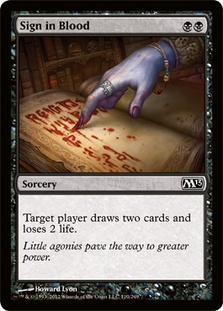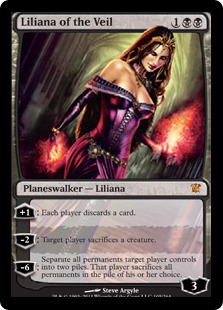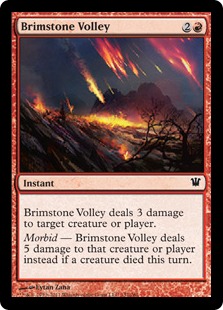Geralf’s Messenger is aptly named. Seriously, try hanging out with that guy. It’s nothing but messaging and more messaging, nonstop. He’s worse than a teen girl outside a movie theatre waiting for her friends to get back from the bathroom.
Geralf’s Messenger: dinner?
Gravecrawler: ok :)
Geralf’s Messenger and Gravecrawler are attacking.
Snapcaster Mage blocks Gravecrawler.
Snapcaster Mage blocks Geralf’s Messenger.
Geralf’s Messenger: brb
Geralf’s Messenger: cya soon GC :)
Undying trigger from Geralf’s Messenger goes on the stack.
Geralf’s Messenger: OK bck :)
Gravecrawler is cast from the graveyard.
Geralf’s Messenger: totally bffs! ILY babe x
(He also seems to like smiley faces, which is weird for a decrepit Zombie oozing green stuff.)
As I write this, the World Magic Cup is entering its final stages. The Magic Olympians from 71 countries have vied for the gold medal. Insectile Aberrations have emerged, Serra Angels have been Murdered, and Snapcaster Mages have flashed back everything from Gitaxian Probe to Spell Snare to Path to Exile. The Magical world is watching Tzu-Ching Kuo playing Modern against Puerto Rico, poised to complete his undefeated streak across multiple formats and multiple days. But quietly, elsewhere in the finals, Geralf’s Messengers are devouring the brains of U/W Delver player Gabriel Perez.
Well, insofar as it’s possible to devour brains quietly. It gets messy.
The Standard portion of the Cup was a small coup for Zombies. Despite only making up a small percentage of the metagame, there were three copies in the Top 4 and only a single Delver deck. Anyone wandering around the tables on Day 1 would have expected more like three Delver lists and a single Wolf Run Blue. Delver showed up in force; it was likely 40-50% of the metagame. But as Gravecrawler well knows, you can’t keep a good man down.
Here’s the list I played in the Cup:
Creatures (24)
- 1 Skinrender
- 1 Phyrexian Metamorph
- 4 Phantasmal Image
- 4 Diregraf Ghoul
- 4 Gravecrawler
- 4 Geralf's Messenger
- 3 Blood Artist
- 1 Butcher Ghoul
- 1 Thragtusk
- 1 Disciple of Bolas
Lands (24)
Spells (12)

As you can see, this isn’t too many cards off from Brad Nelson recent Magic Online baby. Here it is, for comparison:
Creatures (28)
- 1 Skinrender
- 2 Fume Spitter
- 1 Massacre Wurm
- 1 Phyrexian Metamorph
- 4 Phantasmal Image
- 4 Diregraf Ghoul
- 4 Gravecrawler
- 4 Geralf's Messenger
- 4 Blood Artist
- 1 Thragtusk
- 2 Disciple of Bolas
Lands (24)
Spells (8)

Sign in Blood is the difference here. It’s a very Neeman-style card—it gets value, it adds consistency, and it smooths out your bad draws at the cost of decreasing the power of your good ones. Frankly, I love it and wouldn’t consider playing less than three. It’s appropriate in this deck for a few reasons:
- You have a hole in your two-drop slot. Blood Artist is great and all, but four is a bit excessive. He’s outright awful against decks like Esper Control and uninspiring against Ramp and Delver. And Phantasmal Image isn’t a card you want turn 2 on the play.
- You tend to peter out in games you don’t draw Birthing Pod. Two-power one-drops don’t get there anymore, what with how powerful four- and five-drops have gotten. If Geralf’s Messenger eats a Celestial Purge, Diregraf Ghoul won’t beat a Huntmaster of the Fells. Sign in Blood helps a lot here, whether it’s getting you to your Birthing Pods or just providing a steady stream of Zombies to dwindle their life total away.
- Consistency versus power is the watchword of current Standard, and this deck falls heavily on the power side of the spectrum. Zombies is one of the few decks that doesn’t play Ponder, and consequently is more susceptible to screw or flood than a deck like Delver. Fortunately, it makes up for that by being much more powerful. A good Zombie draw will beat a good Delver draw every time—the Geralf’s Messenger / Birthing Pod axis is downright ridiculous and will certainly squelch a mere Geist of Saint Traft or two. You’re happy to spend turn 2 massaging your draw to give yourself a better chance of finding your ridiculous cards at the right time.
- It’s a minor point, but it’s nice that you don’t have to discard when you Sign in Blood turn 2 on the draw. With eight one-drops and four Tragic Slips, you’ll likely be casting a spell the first turn of the game.
Gut Shot in the board has become necessary with the rise of Knight of Glory in Delver boards. The card is actually the perfect solution because you want something you can side in case they play Knight that is also relevant if they turn out to have something else, like Celestial Purge or Sword of Feast and Famine. It might seem excessive to side up to seven small-dude removal spells, but the most important thing against Delver is to keep their Delvers and Geists of Saint Traft off the table. The most common way to lose games isfor them to stick a threat and keep you off Geralf’s Messengers with Vapor Snags and Mana Leaks just long enough to go the distance. Of course, it helps that Gut Shot also kills Blade Splicer in response to Restoration Angel or a Spirit token trying to pick up a Sword.
It’s also huge against the Birds of Paradise decks: Naya Pod and Elves. Birds of Paradise is a better one-drop than Gravecrawler on its own merits (it’s hard to lose a game where you activate Birthing Pod turn 3). But the popularity of Birds/Pilgrim, Delver, and Blood Artist has made Gut Shot incredibly well placed, and Birds pays for its power with its vulnerability. You definitely want seven ways to kill a turn 1 mana dork against the midrange green decks. I’d play up to ten. There’s a massive difference between having four mana on turn 3 versus turn 4, and Gut Shot can be legitimately a zero-mana Time Walk.
The other card I love more than most is Liliana of the Veil. If Gut Shot is your go-to against the aggro and midrange side of the format, Liliana is what you want to be doing every game against control. Interestingly, Trading Post decks were almost non-existent at the Cup last week, so Liliana might be growing less important as the format matures. But it’s also great against Esper and good against ramp, which are most definitely still around.
You want to attack control decks along multiple axes. It’s the classic cliché about there being no such thing as wrong threats, only wrong answers. They may have Nihil Spellbomb for your Gravecrawler and they may have Celestial Purge for your Geralf’s Messenger, but can they also find an Ancient Grudge for your Birthing Pod? Because if not, they lose. Same story for Liliana; they need that Oblivion Ring. Much of the time she’ll go straight up to six loyalty and destroy half their board, leaving them with four lands, no hand, and Forbidden Alchemy in the bin looking lonely. Other times they’ll manage to get a Titan through, but stripped of their follow-up Karn they’ll have no reply to Phantasmal Image copying it and Liliana killing it. Planeswalkers are good against decks that can’t pressure them, make no mistake.
So what do you do in the Delver matchup?
I’m glad you asked! Here’s how I board:
-3 Blood Artist
-1 Diregraf Ghoul
-1 Sign in Blood
+3 Gut Shot
+2 Nihil Spellbomb
You don’t take out Birthing Pods? I thought those were bad against Delver.
That’s an excellent question. There’s a truism in matchup analysis that says that you want to either be a little slower and bigger than the other guy or a lot faster. Say you’re casting Thragtusk while I’m casting Grave Titan—I’ll win because Grave Titan is a much better card than Thragtusk and you only get to hit me for five before Titan comes down. But if instead you play Delver of Secrets, you’ll beat me because Delver hits for an enormous amount before turn 6, so much so that Titan won’t be able to stabilize.
In the past, Delver didn’t care much about Birthing Pod. It’s slow, it does damage to the person with it, and it can be answered by Vapor Snag in response. It has to be in play for quite a few turns before they’re out of the woods. Delver was the guy who was much faster, and to be only a little bit slower you needed to side out Pods and win with Tragic Slip and Geralf’s Messenger. You wanted to be the red version of this deck with more removal spells and less durdling. Playing this deck a few months ago, I cut down to one Pod in the Delver matchup.
But all this changed with the printing of Disciple of Bolas and Thragtusk. Suddenly, Pod isn’t nearly as much of a liability. Instead of wasting time copying Geralf’s Messenger, you’re gaining four life and gaining five next turn. Or you’re fetching out Clones and Skinrenders to kill Delver and Geist and saving a ton of damage. I think it’s correct now to leave all the Pods in, especially since Delver players usually side in answers like Knight of Glory and Celestial Purge. With cards like that, they can adopt the control role and be a little slower than you. Pod also finds Phantasmal Image, which is outstanding against Delver. It kills troublesome Geist of Saint Traft on turn 4 or simply gets value as a Restoration Angel Blinking a Geralf’s Messenger.
Seeing Red
Creatures (23)
- 2 Fume Spitter
- 2 Phyrexian Metamorph
- 4 Diregraf Ghoul
- 4 Gravecrawler
- 3 Falkenrath Aristocrat
- 4 Geralf's Messenger
- 4 Blood Artist
Lands (23)
Spells (14)
Sideboard

Creatures (27)
- 1 Vampire Nighthawk
- 2 Fume Spitter
- 2 Phyrexian Metamorph
- 4 Diregraf Ghoul
- 4 Gravecrawler
- 3 Falkenrath Aristocrat
- 4 Geralf's Messenger
- 3 Highborn Ghoul
- 4 Blood Artist
Lands (22)
Spells (11)

This is the other direction you can take the Zombie deck, highlighted by the two players who took it all the way to Top 4 of the World Magic Cup. I like red against ramp (where Falkenrath Aristocrat is nearly unstoppable) and Elves (where access to Arc Trail and Bonfire is a game-breaker). If you have to break it down to a couple distinctions, it would be that these lists eschew Birthing Pod and Phantasmal Image for Falkenrath Aristocrat and Brimstone Volley.
These cards are less powerful but more consistent. Red Zombies does the same thing every game. It’s single-minded. It’s efficient, it’s ruthless, and it’s bloody. Every card in your deck is about dealing them twenty damage before they can say, "Snapcaster my Ponder." Blood Artist is better here, less as a late game combo piece and more as a Cursed Scroll that synergizes with Mortarpod and Falkenrath Aristocrat better than it ever did with Birthing Pod and Disciple of Bolas. Birthing Pod and Phantasmal Image may be the best cards in Standard when you copy a Blade Splicer and turn it into a Skinrender to kill theirs. But they can also sit dead in your hand or deal you too much damage to race that Restoration Angel plus the timely Vapor Snag.
This article isn’t about telling you which deck is better. I will say that they’re both tier 1 choices that are currently under the radar, so get in quick before that changes at the next StarCityGames.com Open Series! But they do very different things. Brimstone Volley and Falkenrath Aristocrat aim to end the game fast. Pod lists have multiple game plans. You win some percentage of games by simply turning Gravecrawlers and Geralf’s Messengers sideways, and you win some percentage of games by resolving a Pod and getting far in front on turns 4 through 7. Most games are a mix of columns A and B, though. You’ll deal them a little bit of damage early, maybe get them down to ten before they stabilize, then push through the last points with a Pod chain going over the top.
So to sum up:
- Zombies is in a good place right now. Play it and play Sign in Blood.
- Whether you’re red or not, you need a way to kill Knight of Glory and Birds of Paradise. Doesn’t matter if it’s Gut Shot or Arc Trail.
- There are a lot of decks in Standard now that are all pretty good, with no one clear standout the way it was a few months ago. Which one you play depends on where you want to be on the consistency/power spectrum. Whatever it is, make sure you have a ton of practice with it and know every choice inside and out.
- Birthing Pod gets better as the format grows. As the format is at its peak in size, Pod is at its peak in power. Metagame accordingly.
Until next time,
Jeremy



